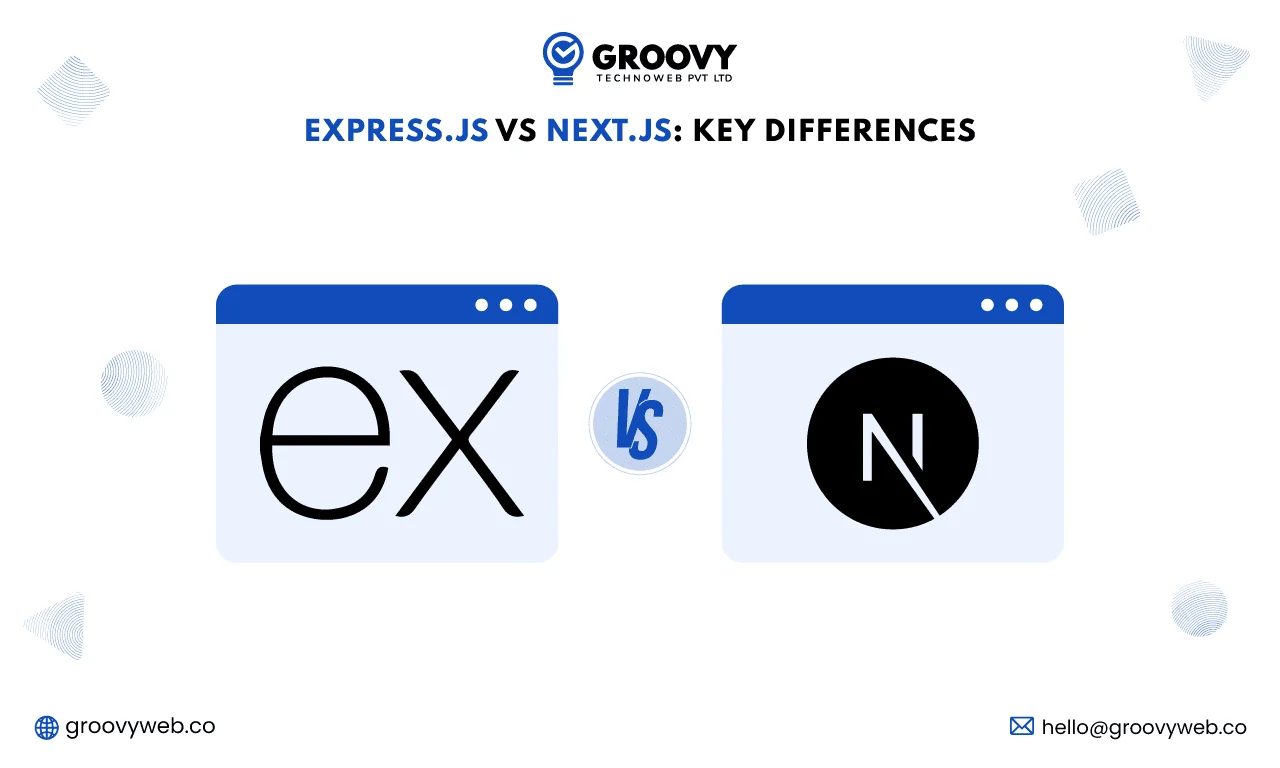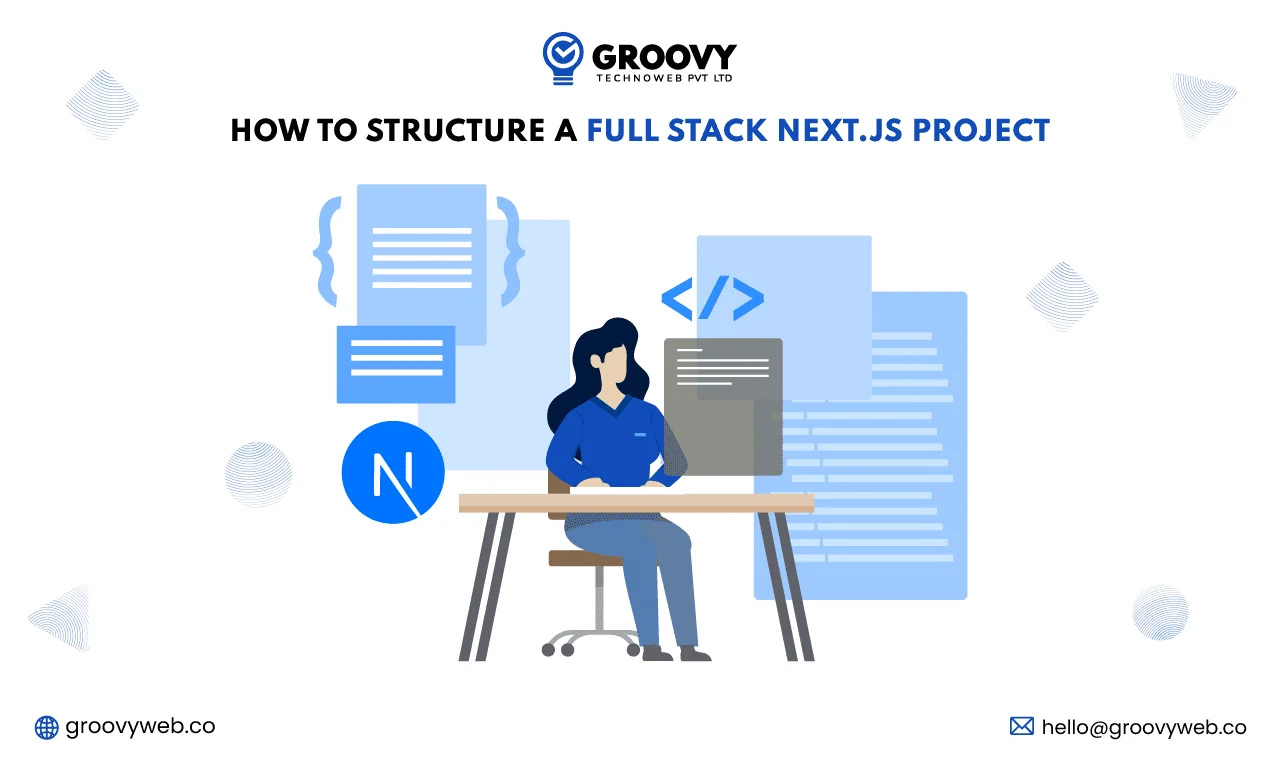Express.js vs Next.js: Key Differences
Sagar Patel
February 27, 2025 74 Views
The proper framework is critical for building efficient and scalable applications in the ever-evolving internet development landscape. Two distinguished players in this area are Express.js and Next.js. While the two are created in JavaScript and streamlining the development system, they meet different needs and functions. This article highlights major differences between those frameworks, providing insight to help the builders make informed decisions.
What is Express.js?
Express.js is a minimalist, unopinionated web application framework for Node.js designed to construct sturdy backend packages and APIs. It affords a thin layer of essential internet utility functions without obscuring Node.js functions. Developers recognise its flexibility, allowing them to structure programs as they see fit. Express.js is broadly used to develop RESTful APIs, deal with middleware, and manage server-side logic. Its lightweight nature ensures that programs can be tailor-made exactly to unique wishes, making it a favoured choice for many backend builders.
What is Next.js?
Next.js is a powerful React-based framework that helps improve complete-stack net programs with features like server-side rendering (SSR) and static website generation (SSG). It abstracts the complicated configurations of React and Webpack, supplying a streamlined development experience. Next.js is preferred for building search engine marketing-friendly applications because it correctly handles SSR, ensuring quicker web page loads and better search engine indexing.
Additionally, it helps API routes, permitting builders to create backend endpoints within the software. This integration of front-end and lower back-end skills makes Next.js a comprehensive answer for modern internet development.
Key Differences Between Express.js and Next.js
Here’s a well-structured table you can use in your blog to compare Express.js and Next.js:
| Category | Express.js | Next.js |
| Architecture and Purpose | Minimalist backend framework for handling HTTP requests, middleware, and routing. | A full-stack framework built on React supports both frontend and backend development. |
| Performance and Speed | Requires manual optimizations for caching, compression, and performance tuning. | Offers built-in performance features like automatic code splitting, SSR, and SSG. |
| Rendering Approach | Primarily relies on client-side rendering (CSR); lacks built-in SSR capabilities. | Supports both server-side rendering (SSR) and static site generation (SSG) for better performance and SEO. |
| API Development and Routing | Provides a middleware-based routing system, making it flexible for building complex APIs. | Uses a file-based routing system with built-in API handling, simplifying backend integration. |
| Scalability and Use Cases | Highly scalable and suitable for microservices, real-time applications, and enterprise-level solutions. | Best for SEO-driven websites, e-commerce platforms, and content-heavy applications. |
| Learning Curve and Developer Experience | Easy to learn for Node.js developers but requires additional middleware for advanced features. | Intuitive for React developers with built-in features but may have a learning curve for beginners. |
| Community and Ecosystem | Well-established ecosystem with extensive middleware and third-party plugins. | The ecosystem is rapidly growing with strong support from Vercel and modern integrations like TypeScript and Tailwind CSS. |
| Security Considerations | Requires manual security setup using middleware like Helmet.js and CORS. | Provides built-in security features such as automatic XSS protection and Content Security Policy enforcement. |
| SEO and Performance Optimization | Lacks built-in SEO features and requires additional configurations for SSR and caching. | Offers out-of-the-box SEO optimizations with SSR, SSG, automatic image optimization, and faster page loads. |
Architecture and Purpose
A framework’s architecture determines how packages are built and advanced, and Next.js caters to exceptional development desires, providing wonderful strategies for coping with Internet applications. Express.js is a minimalist backend framework that handles HTTP requests, middleware, and routing. It is flexible, allowing builders to build APIs and server-side applications with complete configuration management.
However, it lacks built-in rendering or frontend talents, making it ideal for microservices and backend-pushed architectures. In evaluation, Next.js is a full-stack framework built on React that manages client—and server-side rendering. It simplifies dynamic internet utility development by offering built-in routing, data fetching, and rendering solutions. While Express.Js prioritises backend flexibility, Next.js provides established surroundings for developing scalable, full-stack programs with seamless front-end and back-end integration.
Performance and Speed
Performance is important in internet packages, impacting a person’s enjoyment and responsiveness. Express.Js and Next.Js provide one-of-a-kind procedures for performance optimisation, catering to special use cases.
Express.js is a lightweight framework that permits builders to optimise overall performance based on precise utility necessities. It requires a guided setup for caching, compression, and other performance enhancements, giving builders complete control over tuning and scalability.
Since Express.js lacks integrated optimisations, performance largely depends on how efficiently it’s implemented. In assessment, Next.js has integrated optimisations like automated code splitting, static website era (SSG), and server-side rendering (SSR).
These features improve web page load times and beautify rendering efficiency without additional configurations. While Next.js offers better out-of-the-box performance, the rate relies upon the software’s complexity and shape.
Client-Side Rendering vs. Server-Side Rendering
Rendering strategies affect software pace, SEO, and fact-fetching techniques. Next.js and Express.js handle rendering differently, influencing their perfect use cases. Next.js supports default server-side rendering (SSR) and static site generation (SSG). This ensures pages are pre-rendered for quicker shipping and improved search engine optimisation.
These functions make Next.Js ideal for content-heavy websites that require brief preliminary load instances and better search engine ratings. Express.Js, alternatively, no longer provides built-in SSR. Developers must combine additional equipment to allow server-aspect rendering.
By default, Express.js packages rely on client-side rendering (CSR), wherein content is loaded dynamically on the consumer’s browser. While CSR works nicely for positive programs, it may no longer be appropriate for SEO-centered tasks that require faster initial rendering.
API Development and Routing
Developer Survey found that efficient API development is a priority for modern web applications. Over 60% of developers prefer frameworks with flexible routing capabilities. Express.js provides a straightforward approach to API development, allowing developers to define routes and handle HTTP methods easily.
Its middleware-based architecture enables custom API structures, making it ideal for microservices and RESTful applications. However, security and performance optimisations must be handled manually through middleware.
Next.js offers built-in API routing, leveraging a file-based system where the directory structure dictates endpoint availability. While this simplifies backend integration, it may limit complex API designs. Express.js remains the preferred choice for intricate API architectures, while Next.js is better suited for full-stack applications requiring seamless frontend-backend connectivity.
Scalability and Use Cases
A study on scalable web architectures has shown that it handles 40% more traffic than the structure of the application opinion with flexible backend structures. Choosing between Express.js and Next.js depends on scalability needs and project complexity.
Express.js is known for its scalability and adaptability, making it appropriate for high-traffic applications and microservices. Its unexpected structure allows developers to correspond to performance needs, making it a top option for enterprise applications, APIs, and real-time services.
Next.js has been adapted for server-side rendering (SSR) and static site generation (SSG), making it ideal for SEO-driven websites, e-commerce platforms, and dynamic applications.
However, its structured approach can introduce boundaries in large-scale backend development. Express.js is the better choice for projects demanding maximum scaling flexibility.
Learning Curve and Developer Experience
Developers often favour frameworks that minimise setup complexity and provide intuitive workflows. A positive developer experience is built on minimizing friction throughout a developer’s journey, ensuring that workflows are seamless and intuitive.
Express.js provides a direct learning state, especially in Node.js. For people familiar with. It’s minimum design provides flexibility, but developers must integrate additional equipment and middleware for complex applications. A lack of underlying structure can also challenge beginners.
Next.JS provides a pre-configured development environment with SSR, SSG, and API routes during the process opinions. Developers with React experience will find it intuitive, as it makes the reactions on the paradigms.
However, new people may face a steeper learning curve due to the addition to this to react. Overall, Next.JS reduces the configuration overhead and increases the experience of growth.
Community and Ecosystem
According to GITHUB’s Open Source report, Express.JS has more than 64,500 stars, while the next .JS has grown rapidly, crossing 129,000 stars, reflecting its growing adoption. Express.js is older but has an extensive ecosystem with a wide range of middleware and plugins.
Its long-standing presence ensures strong community support, numerous tutorials, and third-party integrations. Next.js provides spontaneous Vercel integration with front-end technologies like Typescript, GraphQL, and Tailwind CSS.
Newer Express.js’s rapid growth and dedicated support compared to Express.js make it a strong contender for full-stack development. The choice between the two often depends on the availability of project-specific libraries and community resources.
Security Considerations
Security is a critical element of net development, influencing utility reliability and integrity. Express.Js and Next.Js have distinct processes for ensuring safety, affecting how vulnerabilities are managed and mitigated.
Express.js requires builders to manually put safety features in force through Helmet.js, CORS, and rate-limiting tools. While this provides flexibility, unsuitable configurations can cause dangers like cross-site scripting (XSS), SQL injection, and DDoS attacks.
Security in Express.js largely depends on how properly builders implement quality practices. In contrast, Next.JS provides built-in security features, including automatic XSS protection, Content Security Policy (CSP) enforcement, and server-side rendering (SSR), which help reduce contact with general weaknesses.
This default security Next.JS is a more secure option for applications that handle sensitive user data and require safety standards. While both frameworks can be effectively protected, Next.JS reduces the risk of misunderstanding with its pre-conference safety enrichment.
SEO and Performance Optimization
SEO and performance are important for web applications, search visibility, and user retention. Both express.js and next.js handle these aspects in different ways, catering to specific use cases. Express.js does not offer the underlying SEO optimisation, requiring developers to apply server-side rendering (SSR) manually.
It makes it less suitable for material-powered or marketing websites that depend on search engine visibility. Performance enrichment, such as cashing and compression, should be configured separately, giving the developers complete control over adaptation.
Next.js includes the underlying SSR and Static Site Generation (SSG), improving search engine sequencing and page load speed. Additional features such as automatic image optimisation and code splitting increase performance without additional configuration.
According to VERCEL’s internal reports, websites using Next.JS have seen 20-30% improvements in SEO rankings, making it a favourite option for e-commerce and material-rich platforms.
Express Server vs Next.js Server – Which One should you choose?
To ensure optimal performance, scalability, and development efficiency, choosing the right structure for your web application is necessary. When Express Server vs Next.js Server, it is important to understand and use matters.
While Express.js is a minimalist backend framework, Next.js is a React-based full-stack framework that offers built-in optimisations. Below, we explore when to use each framework based on scalability, SEO, performance, and architecture.
Choose Express.js if:
You need a flexible backend for REST APIs or microservices. When Express.js vs Next.js, Express. JS is a preferred option for back-end development, offering flexibility and a mild structure. This allows developers to manufacture efficiently REST APIs, making it ideal for microservices architecture.
Unlike Next.JS, which integrates the front and back, it purely focuses on the Express.js server-side logic, providing more and more adaptation to backend functionality. Your focus is on scalability for large data-driven applications.
If you are working with a high-trafficking application that requires handling large amounts of data, Express. JS is a reliable option. Its non-blocking I/O model makes it efficient in processing several requests simultaneously.
Many developers prefer Next.js vs. Express for Next-HiV applications, but Express. JS remains a favourite option for backend-intensive workloads. SEO is not a primary concern. Applications like real-time chat apps, data-powered dashboards, or mobile apps do not require search engine optimisation (SEO).
However, unlike Next.js, Express.js does not offer the underlying SSR or SSG, making it less suitable for SEO-heavy projects. If your application lacks search engine visibility, Express.js is a direct and effective option.
You want full control over middleware and request handling. Express.JS provides complete flexibility in managing requests, middleware, and third-party integration. Express.js vs Next.js, developers often use Express.
The JS is more suitable for applications requiring deep back customisation, such as authentication, logging, and real-time data processing. Your application relies on WebSockets or real-time communication. Express is excellent for real-time communication applications such as JS messaging platforms or collaborative equipment.
It integrates with libraries such as Socket.IO, enabling efficient two-way communication between customers and servers.
Choose Next.js if:
You require server-side rendering (SSR) or static site generation (SSG). Next.js is a favourite option for SEO-focused applications. Unlike Express.js, Next.js provides SSR and SSG; the search engine rankings and page load improve speed.
Next, when comparing the Next.js vs Express, SEO and faster page load speeds are crucial. Working with a Next.js development company can ensure customised SEO performance when creating a business website. Next.JS enables fast-loading pages by preloading content, reducing bounce rates, and increasing user experience.
Unlike express. JS, which is mainly secondary-centered, next. You want built-in optimisations for performance and security. Next.js provides automatic image optimisation, code splitting, and lazy loading. When evaluating Express Server vs. Next.js Serv, Next.js stands out for its built-in security features, which prevent direct access to API endpoints and reduce vulnerabilities.
You need a hybrid framework that supports both frontend and backend functionality. Unlike Express.js, which focuses only on backend development, Next.js allows complete-deformation development within the same project. Its API routes enable backend functions, making it ideal for developers who prefer an all-in-one solution. Many businesses working with a Next.js development company use their abilities to create a scalable web application with minimal setup.
Your application requires dynamic routing with improved page transitions. Next.JS simplifies routing with its file-based system, which offers dynamic routing for parameter-made URLs. The developers compared Express.js vs Next.js to create a spontaneous navigation experience. You want an easy integration with modern frontend technologies.
Next.JS is designed for the response and baskets basket and grapnel and integrates with various state management solutions. Businesses looking to customise their frontier performance often collaborate with a Next.js development company to manufacture modern, scalable applications.
Choosing the Right Framework for Your Project
Next.js adoption grew by 50%, while express.js, with 23 million weekly downloads (NPM trend), remains the most popular backend framework.
- If you are creating a scalable backend or API-operated application, Express.js is the better choice.
- If you need SEO optimisation, high performance, and built-in security, Next.js is more suitable.
Conclusion
Both frameworks cater to different needs in the Express server vs. Next.js service debate. Express.js is a powerful backend framework ideal for scalable APIs, while Next.js offers full-stack capabilities with superior SEO and performance optimisations. The right choice depends on your project requirements and long-term goals.
Written by: Sagar Patel
Sagar Patel is the CTO and Co-founder of Groovy Web. He was involved in the telecommunications & Automation industry during his early career. Still, due to his attitude toward learning anything new and mastering it, he now works as a CTO for Groovy Web. Through their business mindset and logical approach, they have taken their company to the next level; His responsibilities now include all aspects of the business. Among them are finance, process design, and development.
Frequently Asked Questions
We hope these clear your doubts, but if you still have any questions, then feel free to write us on hello@groovyweb.coWhich is better for SEO: Express.js or Next.js?
Next.Js is the stronger desire for SEO-centered applications as it helps server-side rendering (SSR) and static site generation (SSG), which improves search engine visibility and web page load speeds. On the other hand, express. JS, Express. JS does not have the underlying SEO facilities, and additional configuration is required to adapt to the rendering if the search engine rankings, organic traffic, and fast page loads are a priority; Next.js is the preferred option, while Express.js is better suited for backend-driven applications.
Is Express.js or Next.js better for building APIs?
Express.js API is a preferred framework for API development. It provides a mild and flexible atmosphere for building RESTful APIs and microservices. Developers can easily define the routes and middleware, making it suitable for back-and-beverage applications. JS also supports API routes, but it is mainly a full-stack framework for web applications rather than a standalone API. If the goal is to build a scalable backend service, Express. JS is an ideal option.
Which framework is more scalable: Express.js or Next.js?
Both frameworks can be skilled and efficient, but Express. JS is more suited for backend-heavy applications requiring high scalability. Its non-blocking, event-driven architecture enables efficient handling of many concurrent requests. Next.js, while scalable, is more designed for web applications with optimised rendering performance. If scalability is a priority for complex backend procedures, Express. JS is a better option. For frontend-heavy applications with improved user experience, Next.JS provides the underlying adaptation.
When should I use Express.js instead of Next.js?
Use Express. JS, when constructing backend services, APIs, or microservices, requires a flexible and mild structure. It is ideal for applications without SEO, such as real-time chat apps, backend systems, and data-heavy platforms. On the other hand, web applications require fast page loads, SEO optimisation, and front-end performance enhancements. Choosing between them depends on whether the project is backend-focused (Express.js) or full-stack with SEO needs (Next.js).
Related Blog

Ashok Sachdev
How to structure full stack next.js project
Web App Development 17 Jan 2025 11 min read
Rahul Motwani
Boosting Patient Safety And Data Integrity With A Clinical Trial Management System
Mobile App Development 09 Apr 2025 9 min readSign up for the free Newsletter
For exclusive strategies not found on the blog
